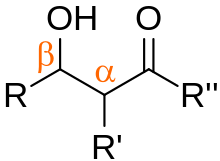Aldol

In organic chemistry, an aldol is a structure consisting of a hydroxy group (-OH) two carbons away from either an aldehyde or a ketone. The name combines the suffix 'ol' from the alcohol and the prefix depending on the carbonyl group, either 'ald' for an aldehyde, or 'ket' for a ketone, in which case it referred to as a 'ketol'. An aldol may also use the term β-hydroxy aldehyde (or β-hydroxy ketone for a ketol). The term "aldol" may refer to 3-hydroxybutanal.[1][2]
Aldols are the product of a carbon-carbon bond-formation reaction, giving them wide applicability as a precursor for a variety of other compounds.
Synthesis and reactions

Aldols are usually synthesized from an aldol addition reaction using two aldehydes or an aldehyde and a ketone for a ketol.[1] These reactions may also be done intramolecularly to form 5 or 6 member rings or for stereoselective syntheses in the active area of asymmetric synthesis.
Aldols may also undergo a condensation reaction in which the hydroxy group is replaced by a pi bond. The final structure is a reactive α,β-unsaturated carbonyl compound, which can also be used in a variety of other reactions:
- RC(O)CH2CH(OH)R' → RC(O)CH=CHR' + H2O
Applications
Aldols synthesized from two aldehydes are usually unstable, often producing secondary compounds such as diols, unsaturated aldehydes, or alcohols.[1] Hydroxypivaldehyde is a rare example of a distillable aldol.[3] The aldol 3-hydroxybutanal is a precursor to quinaldine, which is a precursor to the dye quinoline Yellow SS.[1]
Aldols are also used as intermediates in the synthesis of polyketide natural products and drugs such as Oseltamivir and Epothilone.[4][5][6][7]
See also
References
- ^ a b c d Kohlpainter, Christian; Schulte, Markus; Falbe, Jürgen; Lappe, Peter; Weber, Jürgen; Frey, Guido D. (15 January 2013). "Aldehydes, Aliphatic". Ullmann's Encyclopedia of Industrial Chemistry (7). doi:10.1002/14356007.a01_321.pub3. ISBN 9783527303854. Retrieved 1 April 2023 – via Wiley Online Library.
- ^ PubChem. "CID 21282929". National Center for Biotechnology Information. Retrieved 2023-04-15.
- ^ Zhang, Yanping; Mu, Hongliang; Pan, Li; Wang, Xuling; Li, Yuesheng (21 May 2018). "Robust Bulky [P,O] Neutral Nickel Catalysts for Copolymerization of Ethylene with Polar Vinyl Monomers". ACS Catal. 8 (7): 5963–5976. doi:10.1021/acscatal.8b01088 – via ACS Publications.
- ^ Schetter, Bernd; Mahrwald, Rainer (2006). "Modern aldol methods for the total synthesis of polyketides". Angewandte Chemie International Edition. 45 (45): 7506–25. doi:10.1002/anie.200602780. PMID 17103481.
- ^ Ghosh, Arun K.; Dawson, Zachary L. (2009). "Synthesis of Bioactive Natural Products by Asymmetric syn- and anti-Aldol Reactions". Synthesis. 2009 (17): 2992–3002. doi:10.1055/s-0029-1216941. PMC 6233898. PMID 30443084 – via Thieme.
- ^ Ko, Ji S.; Keum, Ji E.; Ko, Soo Y. (15 October 2010). "A synthesis of oseltamivir (Tamiflu) starting from D-mannitol". J Org Chem. 75 (20): 7006–9. doi:10.1021/jo101517g. PMID 20866058 – via National Library Of Medicine.
- ^ Schinzer, Dieter (2004-06-24), Mahrwald, Rainer (ed.), "The Aldol Reaction in Natural Product Synthesis: The Epothilone Story", Modern Aldol Reactions (1 ed.), Wiley, pp. 311–328, doi:10.1002/9783527619566.ch7, ISBN 978-3-527-30714-2, retrieved 2024-04-15
